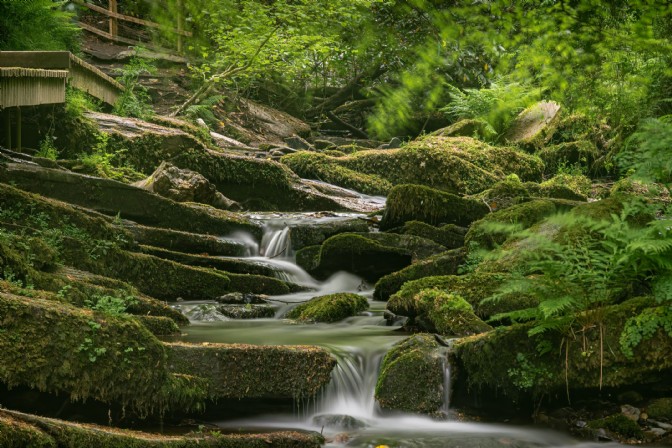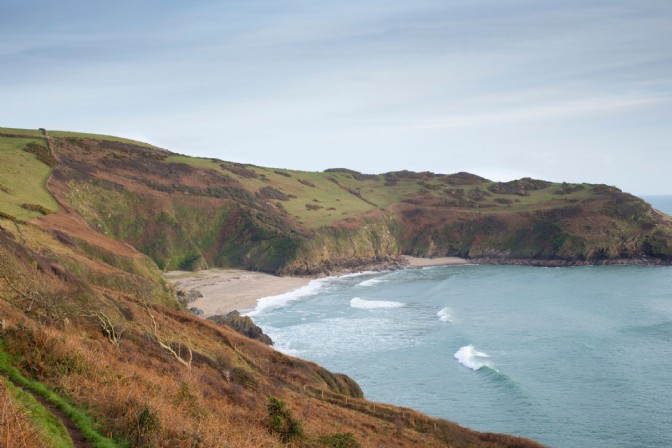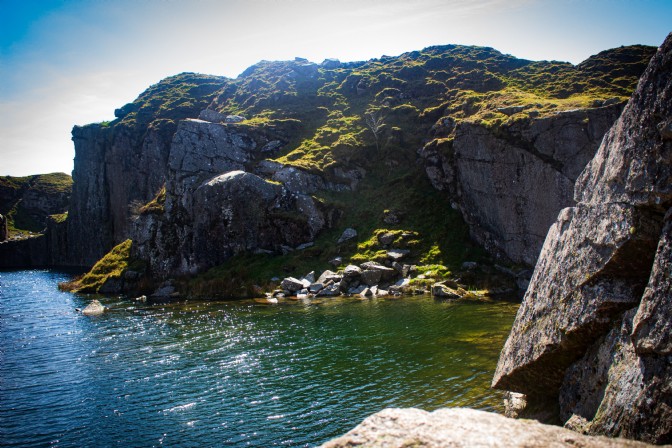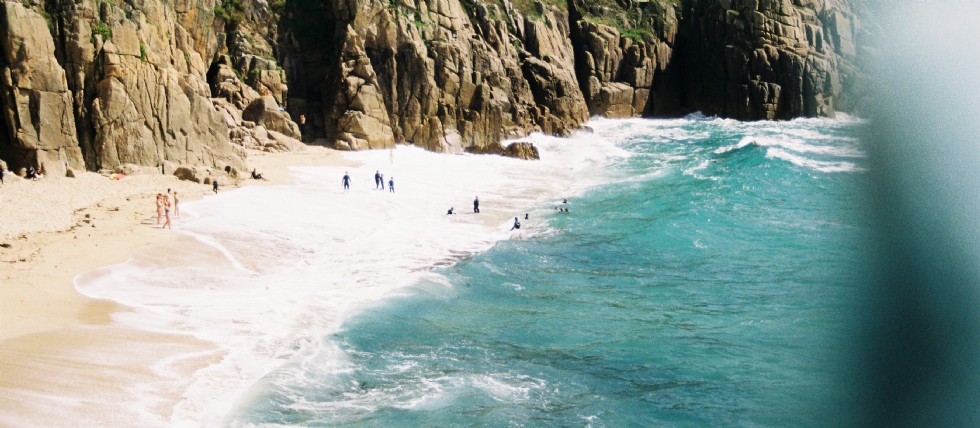Wild swimming has become somewhat of a wellbeing buzzword, with its devoted disciples braving Britain’s inclement weather in pursuit of its far-reaching physical and mental benefits. While the Lake District and Scotland may give it a run for its money, they’re no match for the sheer breadth of wild swimming spots to be found across Cornwall.
From natural pools hewn from Cornish cliffs to spring-fed quarries and waterfalls, the county’s rivers and coastlines prove a spiritual balm for those brave enough to dip their toes. Ready to dive in? These are the top 10 places to go wild swimming in Cornwall.
St. Nectan's Kieve

Wind through wild Atlantic rainforest to reach the sacred site of Saint Nectan’s Kieve (according to legend, Nectan rang a silver bell in times of stormy weather to warn passing ships of the perilous rocks at the mouth of Tingatel’s Rocky Valley). Where the river Trevillet has carved its way through Devonian slate, creating a 60-foot waterfall and natural pool (or “kieve” meaning rock basin), you'll find a mystical setting for wild swimming. After a dip, dry your swimmers under the shade of ivy-clad trees, where ancient ferns conjure up images of faeries, before treating little piskies to Cornish ice cream milkshakes at the nearby café.
How to get there: There is a pay and display car park (£3 for the day, coins only) with limited capacity at peak hours (12-3pm). Throughout the busier summer season, an alternative field car park is available (PL34 0BD). The waterfall is accessible via a mile-long woodland walk. Struggling to find a parking space? Park at Tintagel Visitor Centre Car Park and catch the number 95 bus to Trethevy, which stops directly opposite St Pirans Church where the trail to St. Nectan’s Kieve begins.
Where to stay: Gypsea Rocks
Lantic Bay

Surrounded by near-vertical sea cliffs, this secluded cove is only accessible by a steep coastal path or boat – but it’s well worth the effort to find. Peer through the bracken and gorse, where you’ll spy the sparkling Atlantic waters and a crescent of sugar-soft sands beckoning below. With the rising tide, Great Lantic is separated from Little Lantic; swim around the headland and you’ll likely have this secluded bay all to yourself.
How to get there: Park in the National Trust Lantic Bay Car Park. From here it’s a 15-minute walk from the car park to the beach. There are no facilities on the beach – which helps preserve its hidden gem appeal – so do make sure you pack provisions for a post-swim refuel.
Where to stay: Raffia
Golitha Falls

Set on the southern edge of Bodmin Moor, Golitha Falls is a collection of gentle cascades and natural pools and, unsurprisingly, very popular with tourists in peak season. What the insiders know, though, is that if you pass the main waterfall, you’ll find a rugged track that leads to another hidden ravine. Surrounded by clambering vines, moss-mottled rocks, and ancient oak tree canopies, you’ll feel far from the madding crowds, here.
How to get there: Park at Golitha Falls Car Park. From here, it’s a 15-minute walk to the main falls then a further five-minute walk along a trail to reach the hidden river.
Where to stay: Little Inka
Helford River

The Helford River estuary is bespeckled with secluded creeks and coves for wild swimming (Pernarvon Cove, Bosahan Cove, and Porth Saxon to name a few), but our pick of the bunch is Frenchman’s Creek. Made famous by Daphne du Maurier, Frenchman’s Creek is bordered by lush foliage and boasts languid waters that are welcoming for beginners. Be sure to visit at high water, for the creek dries out at low tide.
How to get there: Park in Helford village, then head west past Penarvon Cove and follow the footpath signs for five kilometres to reach Frenchman’s Creek.
Where to stay: Tangle Bay
Goldiggins Quarry

On summer days, this spring-fed quarry appears like a mirage on the wild moors of Bodmin. The 20-minute route passes rocky tors, Neolithic stones, and endless swathes of bracken, to reach Goldiggins' clear waters. Adrenaline junkies can jump right in from the highest cliffs, but there’s a gradual build-up from the smallest jumps (around two feet) for beginners to build their confidence. Prefer life on dry land? The smooth rocky outlets make an idyllic spot for spectating and sunbathing.
How to get there: Park at Hurlers Car Park in Minions, before taking the 20-minute trail to the quarry past three circles of Neolithic stones.
Where to stay: Artist’s Retreat
Porthtowan Tidal Pool

Flanked by dramatic sea cliffs and flaxen shores, West Cornwall’s Porthowan Tidal Pool might be a task to find but, in our opinion, that makes it all the more rewarding – ask the local lifeguards for help, should you lose your way. The beach itself is popular with surfers, but you’ll want to head north past the barrels and breakers to reach this secluded wild swimming spot. In years gone by, the pool was accessible by concrete steps from the coastal path, but these have gradually crumbled away; today, you’ll need to wait until low tide and reach it sand-side over barnacle-covered boulders.
How to get there: Park at Porthtowan Council Car Park (free from October 1st to April 1st). As mentioned, the pool is only accessible two hours either side of low tide, check tide times or ask the lifeguard’s advice to ensure you don't get stranded.
Where to stay: Monterey
Carn Marth

When rough oceans put heed to your wild swimming plans, head to Carn Marth, an old granite quarry near Redruth where the water is always inviting – if a little bracing outside the balmier summer season. Surrounded by gorse and native wildflowers, the main quarry can draw the crowds, but there’s a smaller, quieter quarry (Cathedral Quarry) which is equally paradisial. Before heading for home, pay Gwennap Pit a visit; this open-air amphitheatre is best known as the preaching place of John Wesley, the Father of Methodism.
How to get there: Road parking on Carn Marth Lane (TR16 5TA) is limited, so it’s worth getting here early to secure a coveted spot. From there, take the steep trail to the left of the engine house towards the quarry – you can’t miss it.
Where to stay: The Viewing Gallery
Kynance Cove

Kynance Cove is one of Cornwall’s most photographed wild swimming spots – and with good reason, too. As the tide retreats, stretches of golden sand appear between the rocky crags, inviting swimmers to explore one cove to the next. Whatever you do, don’t miss Mermaid Pool; a deep sea pool hidden behind the rugged buttresses with natural springboards to cannonball into the crystalline water below, it’s a see-it-to-believe-it sort of place.
How to get there: Park at the National Trust Kynance Cove Car Park. From there, it’s a 10-minute walk to the beaches, which tend to appear one or two hours after high tide.
Where to stay: Wildwood Holt
Bude Sea Pool

Constructed back in 1930, this vast ocean pool spans 3,500 square metres, making it the region’s biggest by some stretch. Its length makes it a satisfying wild swimming spot for seasoned pros clocking laps, but it’s safe for all levels and armband-clad little ones, too, with lifeguards on patrol during the summer months. It’s run today by the Friends of Bude Sea Pool Charity, so if you do dip your toe, consider donating to support this local treasure for generations to come.
How to get there: Park at Summerleaze Beach Car Park. At low tide, access the pool by crossing the flat beach and climbing two short flights of steps to the water. At medium or high tide, access the pool via the upper access road from the beach end of the car park. Follow a short path behind the café to join the coastal path, then head down the concrete steps that lead from the lifeguard hut.
Where to stay: Northcott Beach House
St. Michael's Mount

If you’re an experienced wild swimmer seeking a challenge or training route, this 2.5 kilometer swim across the causeway to St Michael’s Mount is worth bookmarking. The views from the mirror-clear water are second-to-none, as you leave the harbour wall behind and the castle looms in the distance. Prefer to swim in a pod? Sea Swim Cornwall offers guided swims throughout the year, or you can participate in Chestnut Appeal’s annual charity swim in August.
How to get there: The starting point for the swim is Marazion Beach, though you can depart from the causeway at mid to high tide. There’s ample parking at St Michael’s Mount & Long Stay Marazion car park, as well as an overflow car park opposite for peak season (TR17 0EG).
Where to stay: Holanen
Browse the full collection of luxury self-catering cottages in Cornwall or make an enquiry.







